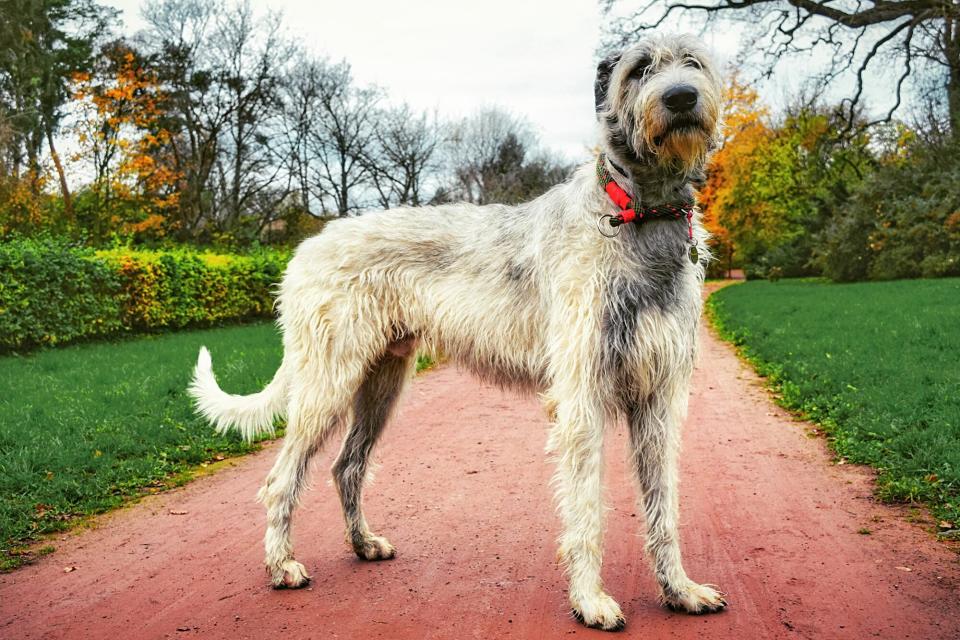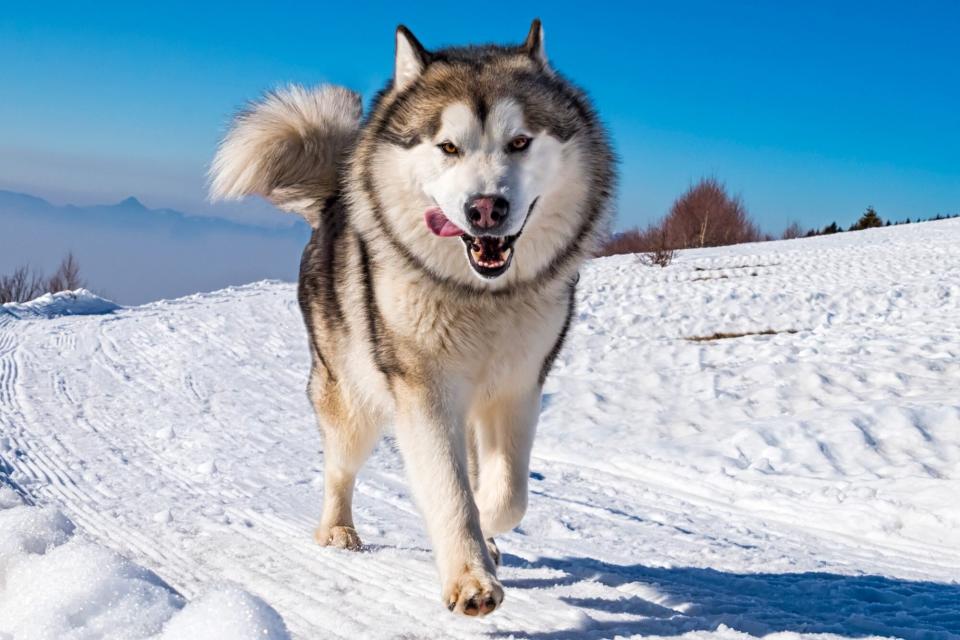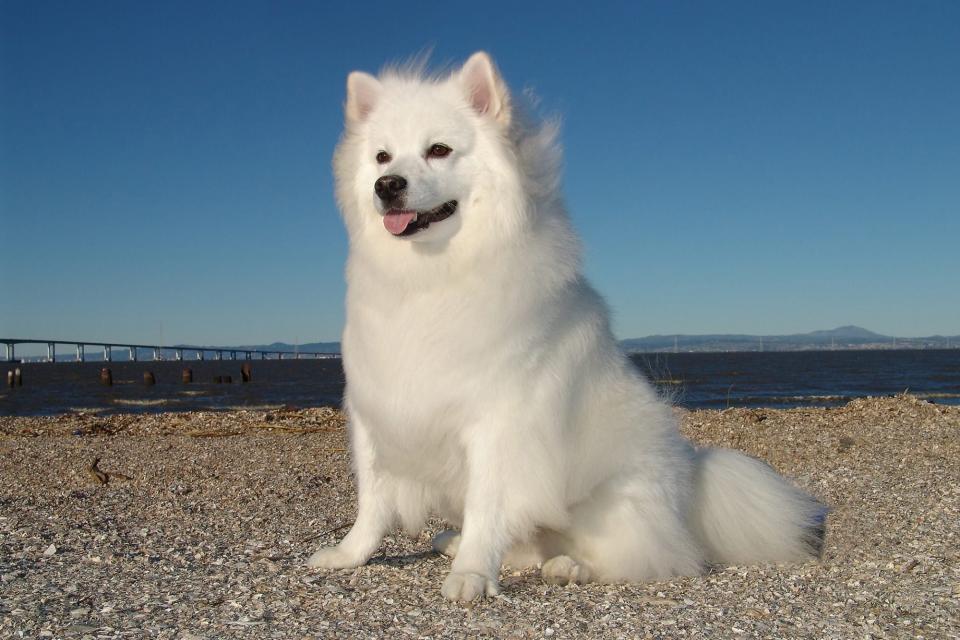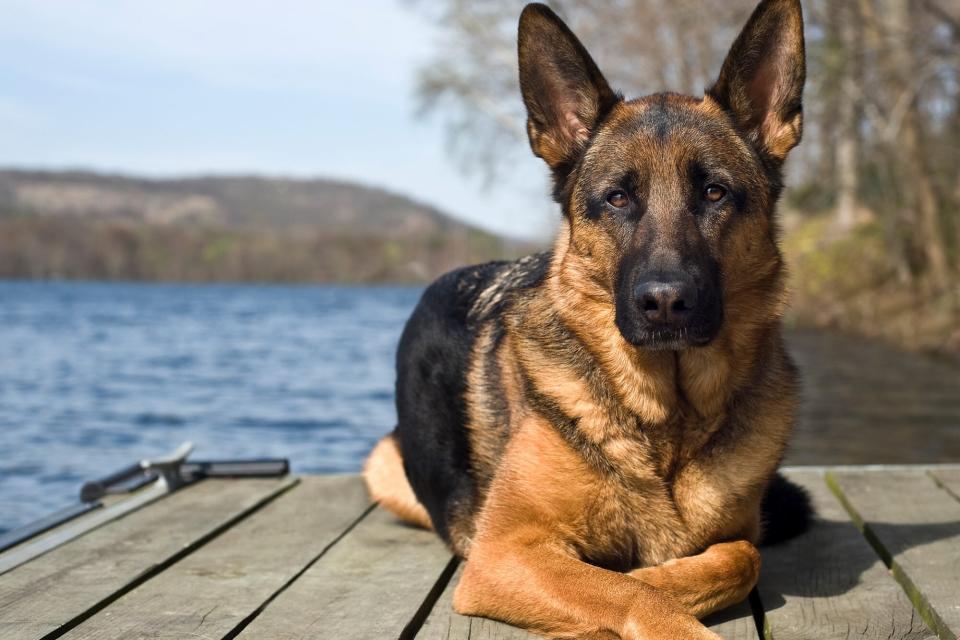12 Wolf Dog Breed Doppelgängers Who Will Make You Do a Double-Take

Nicola Colombo / Getty
Quit monkeying around! As kids, we heard this shouted down the hallway as we tried—and failed—to hide our childish antics while doing homework or when dragging our feet during a troublesome chore. If we only knew then as we sheepishly snapped to attention, we actually have our ancestors to blame. Humans are distantly related to monkeys, lemurs, and apes, but wait: it gets even more bananas. Nearly 99 percent of our DNA is identical to a chimpanzee's, according to the American Museum of Natural History—yet you probably would never guess just by looking.
The same can't be said for our canine companions who bear striking resemblance to wolves in the wild. Some wolf-like dogs may even warrant a double take when you pass them on the street, but rest assured—these breathtaking dog breeds are more closely related to the cute little Chihuahua than they are to their carnivorous cousins staking claim to the woods.
Are Dogs Descended from Wolves?
Though it was commonly believed that all dogs are descended directly from the gray wolf we recognize today, genetic testing found domesticated dogs are actually derived from a now extinct relative of the gray wolf, says Jerry Klein, DVM, chief veterinary officer for the American Kennel Club (AKC). Still, dogs share 98.8 percent of their DNA with wolves—and this applies to all dog breeds, not just the wolf dog doppelgangers.
"Though certain breeds of dogs may appear more 'wolf-like,' they are actually not 'more related' to wolves than other breeds of dogs," Klein says. "Domesticated dogs are genetically more similar to each other than they are to wolves."
Of course, a notable difference between dogs and wolves is the adaptability to humans. Dogs today have evolved to read and respond to human body language and facial expressions. Like wolves, dogs do thrive in packs, but not the fluffy, furry kind.
"Dogs are amenable to human companionship as their pack," Klein says. "Wolves are by nature fearful and shy with humans. Their pack is with other wolves."
If you're looking to expand your pack and find yourself drawn to the athletic prowess and powerful grace of the wolf, these dog breeds that look like wolves can deliver the best of both worlds.
Siberian Husky

Jaliyah Carr / Student / TimberDriveES / 500px / Getty
Ranked as the AKC's 16th most popular breed of 2020, the Siberian husky's sleek athletic aesthetic and piercing eyes are well-recognized as the quintessential wolf dog breed—in fact, the Siberian husky can be traced back to a wolf relative more than 35,000 years old. Bred as working dogs and successful as sled dogs, Siberian huskies notably saved the day in an early 20th century epidemic, taking the reins as the sled dogs that delivered the miraculous medicine across more than 600 miles of Alaska terrain. This breed is not one to sit still!
"This athletic breed requires a lot of exercise, therefore running with their owners or partaking in some dog sports will benefit them," Klein says.
RELATED: 15 Energetic Dog Breeds for People With an Active Lifestyle
Irish Wolfhound

Kathleen Nicolai / EyeEm / Getty
Standing up to 3 feet tall and weighing in at up to 180 pounds, Irish wolfhounds are gentle giants who make great family pets despite their dominant stature, though they do best with older children. Funny enough, Irish wolfhounds were originally bred to hunt wolves and were so successful in their endeavors they almost went extinct in the 1700s once the threat of predators diminished. Thankfully, they were revitalized into the hearty hounds we welcome into our homes today.
Samoyed

zhao hui / Getty
The dog breed equivalent of a marshmallow, these fluffy white wolf-like dogs are well-suited for winter weather.
"Thanks to their double coats, Sammies can withstand even the coldest and harshest weather," Klein says. "The Samoyed is also known for having a characteristic 'smile' due to the upward curvature of its black lips."
The best way to keep him smiling? Plenty of outdoor activity! Don't be surprised if you see a flash of white streak by—these fast fluffballs love to play chase and burn off energy.
Caucasian Shepherd Dog (Caucasian Ovcharka)

Vlad Karavaev / Adobe Stock
Don't let their teddy bear looks and lolling tongues fool you. Though big softies to their people, the Caucasian shepherd dog has protective tendencies for their home and its residents. The Caucasian Shepherd Club of America recommends experienced dog owners only, with plenty of time to dedicate to the socialization and training of their pup. Crate training is a must, according to the club, and positive reinforcement is effective when teaching desired behaviors.
Alaskan Malamute

Nicola Colombo / Getty
Another successful sled dog, the Alaskan malamute—or ''mals'' as they are affectionately known—enjoy being put to work. Adventurous and strong, muscular mals enjoy treks through various terrains and can be quite helpful companions if you allow them to carry your supplies. They should not be left to sit still for long—but do ensure they can sit still long enough for daily grooming. Klein recommends using both a pin brush and metal comb on their thick coats.
RELATED: Here's What It's Like to Have 15 Sled Dogs in the Sierra Nevada Mountains
Scottish Deerhound

nemoris / Getty
While they look very similar to the Irish wolfhound the Scottish deerhound is a different breed, historically known for hunting deer in the Scottish highlands (as the name suggests). Large and in-charge, the Scottish deerhound has a commanding presence but a relatively calm demeanor. Though well-suited for families, Scottish deerhounds with the best of intentions may knock small children over, so homes with older kids are recommended. Their large size is not meant to be locked in a small apartment, so homes with fenced-in yards to roam freely are best.
RELATED: 11 Big Dog Breeds That Deserve Lots of Love
Belgian Malinois

Ирина Орлова / Adobe Stock
"The Belgian Malinois has an intensity that requires constant activity and needs to be actively engaged with his owner, both mentally and physically," Klein says. "Daily walks are not enough for this breed, therefore it's important to introduce them to more high energy activities such as running, biking, hiking, and even participating in dog sports such as agility, herding, and tracking."
Commonly mistaken for a German shepherd, the Belgian Malinois is its own distinct breed, but both breeds are popular picks in the police force and military.

nwbob / Getty
American Eskimo
The American Eskimo is similar to its cloud-like counterpart in the Samoyed but is a lot smaller, coming in three sizes: toy, miniature, and standard, weighing as little as six pounds. Tiny but full of energy, these pups are perfect paired with children and may make quite the dynamic duo as they keep each other entertained.

I love Photo and Apple / Getty
Borzoi
Formerly known as the Russian wolfhound, borzoi dogs are named for their speedy status—"borzoi" is a play on a Russian word meaning "swift." Members of the Russian aristocracy bred the borzoi to hunt wolves and other game, and today's borzoi are best in homes with large, fenced-in yards to run freely, though they would be fine in an apartment so long as ample opportunity for exercise is provided. In fact, the quiet nature of this bounding breed may appeal to apartment dwellers.

Vera Reva / Adobe Stock
Swedish Vallhund
A relatively rare breed in America—though similar in appearance to the AKC's 11th most popular breed in America, the Pembroke Welsh corgi—the Swedish Vallhund shares history with the Vikings dating back more than 1,000 years and were originally bred as herding dogs for Swedish farmers, according to the Swedish Vallhund Club of America. The versatile Vallhund is well-suited for a variety of families and lifestyles, amenable to activity and training and friendly with children and other animals.

Jody Trappe Photography / Getty
German Shepherd
"German shepherd dogs have consistently been one of the most popular breeds in the U.S.," Klein says. "Currently, the German shepherd dog ranks as the third most popular dog breed in the U.S."
Adored by many families, these people pleasers often protect and serve, a popular breed to work amongst police or in the military. However, the average home will find these pups to be playful pets who rarely leave their loved one's side. German shepherds are happiest around their people and should not be left alone for long periods of time.

gebut / Getty
Tamaskan
Early ancestors of the tamaskan were known simply as "wolf look-alikes" as breeders strived for what today is known as the tamaskan breed, though the breed is not currently recognized by the AKC. According to the Tamaskan Dog Register, "His body proportions, form, and movement resemble that of a wolf: balance of power, agility and endurance." In fact, the breed name originates from "tamaska" meaning "mighty wolf."

